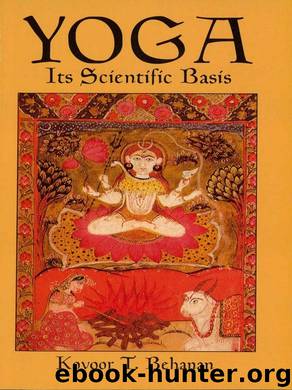Yoga by Behanan Kovoor T.;

Author:Behanan, Kovoor T.;
Language: eng
Format: epub
ISBN: 1900341
Publisher: Dover Publications
Published: 2012-10-06T04:00:00+00:00
The reference to gradations of clarity in consciousness is in no way conclusive and has no more evidential value than such analogous statements as: “There are so many gradations in illumination–from the brightest and most dazzling light to the dimmest glimmer–that we may conclude that there is no such thing as darkness at all”; or, “There are varying degrees of vitality, consequently there is no such thing as death.” Such statements may in a certain sense have a meaning, but for practical purposes they are worthless. This will be seen if one proceeds to draw certain conclusions from them, such as, “it is not necessary, therefore, to strike a light,” or “therefore all living things are immortal.” Further to include “what is unnoticeable” under the concept of “what is conscious” is simply to play havoc with the one and only piece of direct and certain knowledge that we have about the mind. And after all, a consciousness of which one knows nothing seems to me a good deal more absurd than an unconscious mind. Finally, this attempt to equate what is unnoticed with what is unconscious is obviously made without taking into account the dynamic conditions involved, which were the decisive factors in formulating the psychoanalytic view. For it ignores two facts: first, that it is exceedingly difficult and requires very great effort to concentrate enough attention on something unnoticed of this kind; and secondly, that when this has been achieved the thought which was previously unnoticed is not recognized by consciousness, but often seems utterly alien and opposed to it and is promptly disavowed by it. Escaping from the unconscious in this way and taking refuge in what is scarcely noticed or unnoticed is, therefore, after all only an expression of the preconceived belief which regards the identity of mental and conscious as settled once and for all.63
The last sentence is significant in that it shows that the arguments of the critics were based on a confusion of terminology. Neither psychoanalysis nor yoga would admit that conscious and mental are identical. But it is true that the overwhelming tradition of several centuries and the terminology of academic psychology have used these terms interchangeably. Since there is no indubitable evidence to prove the identity of the two, the adherents of the doctrine of the unconscious are quite justified in treating the conscious as a property or manifestation of the mental. Once the distinction has been grasped, arguments of this kind should become invalid.
Another group of criticisms, more basic than the previous ones, has been advanced by the biological sciences, particularly by naturalistic psychology. The essence of this criticism is that a scientific concept of the unconscious, if it is to become compatible with the already established knowledge, should have a biological foundation. Although our present knowledge is pitiably meager, we have sufficient evidence for the close relationship between the manifestation of consciousness and the nervous system. The inference that there can be no idea without a corresponding change in the brain is, while not conclusively demonstrable, a logical conclusion from available evidence.
Download
This site does not store any files on its server. We only index and link to content provided by other sites. Please contact the content providers to delete copyright contents if any and email us, we'll remove relevant links or contents immediately.
Unwinding Anxiety by Judson Brewer(70173)
The Art of Coaching by Elena Aguilar(50017)
The Fast Metabolism Diet Cookbook by Haylie Pomroy(20488)
Rewire Your Anxious Brain by Catherine M. Pittman(17589)
Healthy Aging For Dummies by Brent Agin & Sharon Perkins RN(16610)
Talking to Strangers by Malcolm Gladwell(11878)
The Art of Thinking Clearly by Rolf Dobelli(8842)
Crazy Rich Asians by Kevin Kwan(8349)
Mindhunter: Inside the FBI's Elite Serial Crime Unit by John E. Douglas & Mark Olshaker(7834)
The Compound Effect by Darren Hardy(7559)
Crystal Healing for Women by Mariah K. Lyons(7376)
Therapeutic Modalities for Musculoskeletal Injuries, 4E by Craig R. Denegar & Ethan Saliba & Susan Saliba(7349)
Periodization Training for Sports by Tudor Bompa(7328)
Bodyweight Strength Training by Jay Cardiello(7185)
Becoming Supernatural by Dr. Joe Dispenza(7106)
Wonder by R. J. Palacio(7059)
Tools of Titans by Timothy Ferriss(6947)
Should I Stay or Should I Go? by Ramani Durvasula(6785)
How to Be a Bawse: A Guide to Conquering Life by Lilly Singh(6693)
